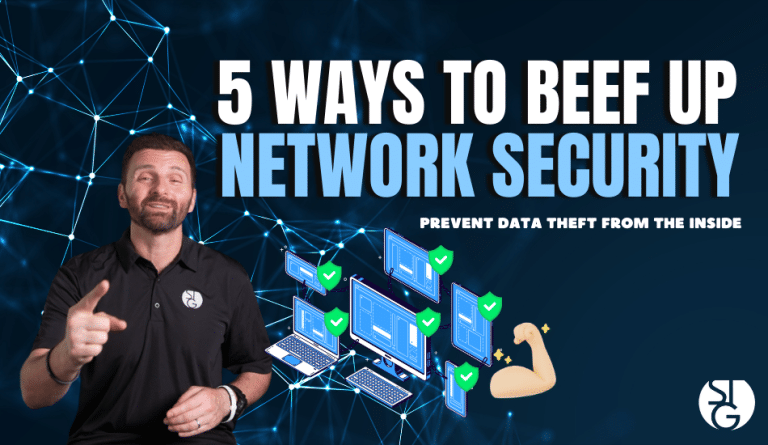It seems like every click and keystroke we make, echoes through cyberspace. The struggle for data security continues. Businesses stand as both targets and guardians in this battle. Their digital assets are constantly sought after. Today, we’ll explain how to strategically organize your cybersecurity plan – just in time for the new year.
To be able to successfully negotiate this terrain, it takes a two-pronged approach. Companies need to equip themselves with a high-level set of cybersecurity tools and strategies. On one side, focus on prevention (Left of Boom). On the other side, recovery (Right of the Boom).
These strategies work together to create the cornerstone of an all-encompassing defense. They help guarantee businesses can fend off threats. And, rise from the ashes should they suffer a breach.
What is “The Boom” and what is Right and Left of it?
The phrase “Left of Boom” and “Right of Boom” have a very specific meaning in the world of cybersecurity. They distinguish between the proactive and reactive approaches to cybersecurity. “The Boom” is the threatening cybersecurity event that can or will happen.
“Left of Boom” describes preventative tactics and proactive efforts. These measures are put in place to protect against possible security breaches. It includes steps taken to stop cyber incidents before they happen.
“Right of Boom” refers to the recovery plans implemented after a breach. Businesses use these strategies following a security incident. Things like data backup and incident response preparation are part of this phase.
These strategies come together to create a comprehensive cybersecurity plan. They address aspects that both prevent and recover. The goal is to increase an organization’s resistance to cyberattacks.
Left of Boom Prevention Strategies
Awareness and User Education
Employee Cybersecurity training is a core Left of Boom aspect. Regular training will empower your staff. Human error is the most common way security incidents can occur, so helping staff detect phishing emails is a great first step. In addition, keep them up to date on social engineering attempts and practice safe online behaviors. A knowledgeable workforce serves as a powerful barrier against possible attacks.
Employee training lowers the likelihood of falling victim to phishing attacks by over 75%.
Strong Authentication and Access Control
Strict access control procedures lower the possibility of a compromise. It helps guarantee that workers only have access to the tools essential to their jobs.
Among the strategies for access control are:
- Least Privilege Access
- Multi-factor authentication (MFA)
- Contextual access
- Solutions for Single Sign-on (SSO)
Regularly Update Software and Patch Management
Cybercriminals often take advantage of vulnerabilities in outdated software. One of the Left of Boom techniques is to make sure that all software is up-to-date. The most recent security patches must to be installed. Tools for automated patch management can make this procedure more efficient. They shorten the vulnerablity window.
Firewalls and Network Security
The first line of protection against threats from the outside is a firewall. Install systems for intrusion detection and prevention and firewall defense. They can assist in monitoring network traffic and spotting questionable activity. They also aid in thwarting attempts by unauthorized users to get access. Network setups that are secure are crucial in preventing unwanted access to confidential information.
Frequent Vulnerability Assessments and Security Audits
Perform vulnerability assessments and security audits on a regular basis. This aids in locating any possible holes in your systems. Through proactive mitigation of these vulnerabilities, entities can mitigate risk. They can lessen the likelihood that hackers will take advantage of them.
Additionally, penetration testing can mimic actual cyberattacks. Businesses are able to assess their security posture more efficiently as a result.
Right of Boom Recovery Strategies
Incident Response Plan
It is imperative to establish a well-defined incident response plan. The actions to be taken in the case of a security breach should be described in this strategy.
It ought to contain items such as:
- Protocols for communication
- Procedures for containment
- Actions for getting better
- IT contact information
Test and revise your incident response plan on a regular basis. This guarantees its continued efficacy and relevance.
Disaster Recovery and Data Backup
Regular data backups are essential to Right of Boom. Having a strong catastrophe recovery strategy is another essential element.
Regular backups of important data can be guaranteed via automated backup solutions. Additionally, it should be ensured that in the case of a breach, it can be promptly restored. Following an incident, a disaster recovery plan enables organizations to quickly restart operations.
Forensic Analysis
Follow up on a security compromise with a comprehensive forensic investigation.
Organizations can further strengthen their security posture by learning from these instances. This lessens the likelihood that such attacks will be successful in the future.
Legal and Regulatory Compliance
Navigating the legal and regulatory landscape after a security breach is important. Organizations must follow data breach notification rules and regulations. Timely and clear communication with affected parties is vital. It’s vital to maintaining trust and credibility.
Get Help with a Strong 2-pronged Cybersecurity Strategy
Using Left and Right of Boom methods might strengthen your security stance. These terms help you consider both important aspects of a strong defense.
If you’d like some help getting started, give us a call today to schedule a talk.
If you’d like to learn more about what’s new in the tech world, follow our blog!
Click here to schedule a free 15-minute meeting with Stan Kats, our Founder, and Chief Technologist.
STG IT Consulting Group proudly provides IT Services in Greater Los Angeles and the surrounding areas for all your IT needs.





